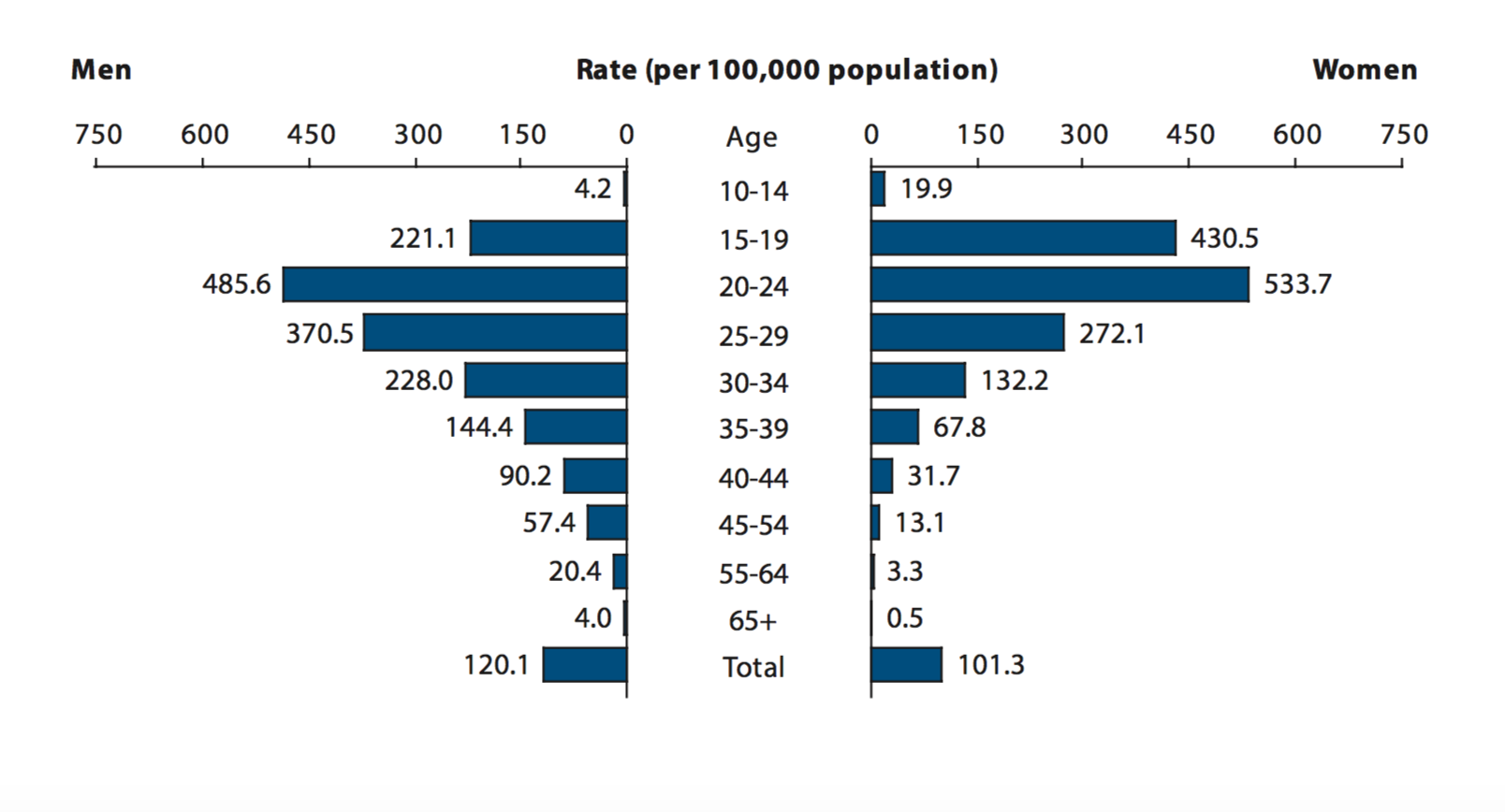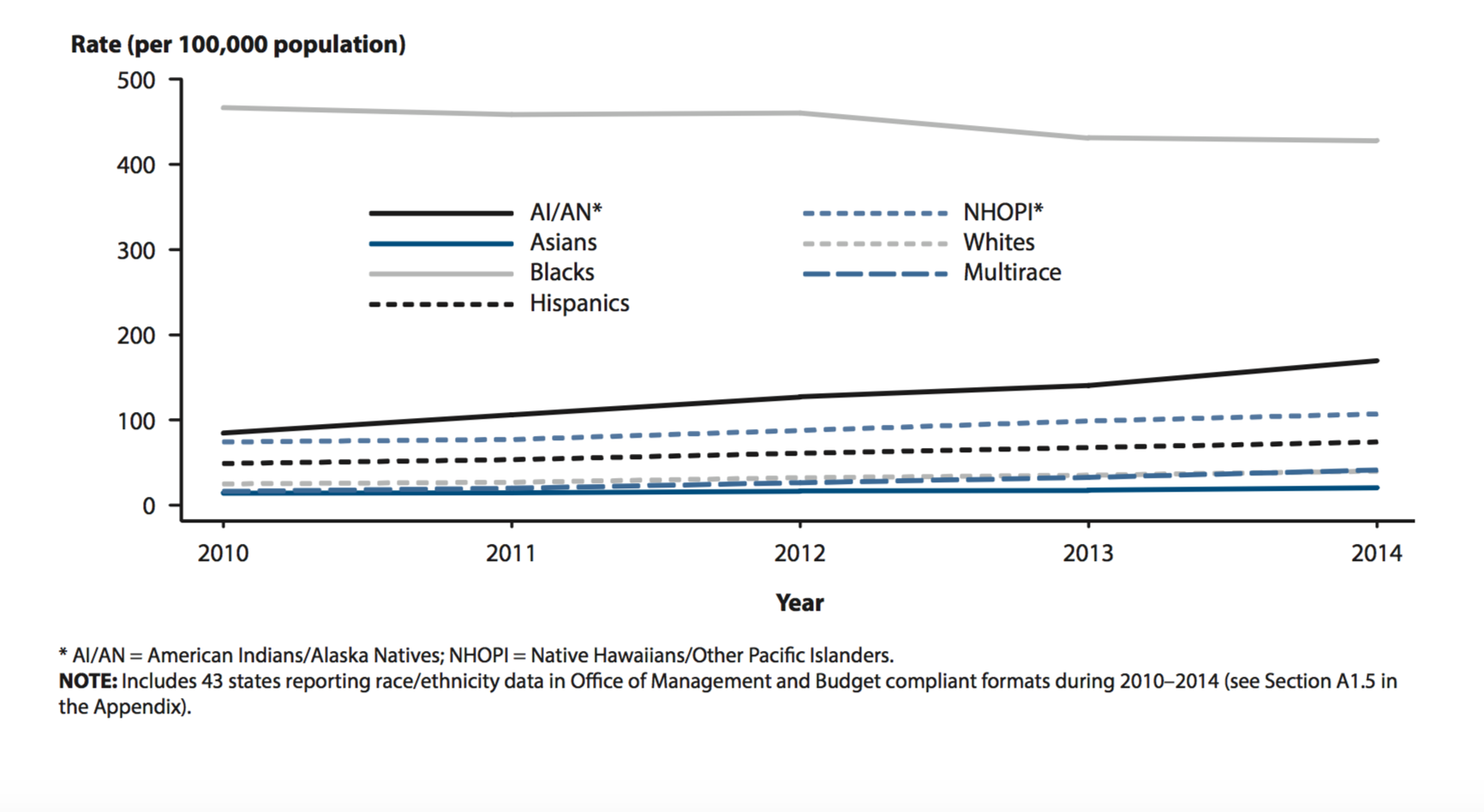Gonorrhea epidemiology and demographics: Difference between revisions
Jump to navigation
Jump to search
| Line 9: | Line 9: | ||
*After a small increase in 1998, the gonorrhea rate has decreased slightly since 1999. | *After a small increase in 1998, the gonorrhea rate has decreased slightly since 1999. | ||
*In 2012, gonorreha represents 106 million of the estimated 498 million new cases of curable STIs – that also includes syphilis, chlamydia and trichomoniasis.<ref name=Gonorrhea-fact> World Health Organization. Emergence of multi-drug resistant Neisseria gonorrhoeae http://apps.who.int/iris/bitstream/10665/70603/1/WHO_RHR_11.14_eng.pdf Accessed on September 8, 2016</ref> | *In 2012, gonorreha represents 106 million of the estimated 498 million new cases of curable STIs – that also includes syphilis, chlamydia and trichomoniasis.<ref name=Gonorrhea-fact> World Health Organization. Emergence of multi-drug resistant Neisseria gonorrhoeae http://apps.who.int/iris/bitstream/10665/70603/1/WHO_RHR_11.14_eng.pdf Accessed on September 8, 2016</ref> | ||
*In 2014, a total 350, | *In 2014, a total 350,062 cases gonorrhea were reported in United States.<ref name=CDC-factsheet> Centers for Disease Control and Prevention. Reported STDs in the United States 2014 National Data for Chlamydia, Gonorrhea, and Syphilis http://www.cdc.gov/std/stats14/std-trends-508.pdf </ref> | ||
===Age=== | ===Age=== | ||
Revision as of 11:53, 29 September 2016
|
Gonorrhea Microchapters |
|
Diagnosis |
|
Treatment |
|
Case Studies |
|
Gonorrhea epidemiology and demographics On the Web |
|
American Roentgen Ray Society Images of Gonorrhea epidemiology and demographics |
|
Risk calculators and risk factors for Gonorrhea epidemiology and demographics |
Editor-In-Chief: C. Michael Gibson, M.S., M.D. [1]; Associate Editor(s)-in-Chief: Sara Mehrsefat, M.D. [2]; Priyamvada Singh, MBBS [3]
Epidemiology and demographics
Incidence and Prevalence
Gonorrhea is a very common infectious disease.
- In the period from 1975 to 1997, the national gonorrhea rate declined, following the implementation of the national gonorrhea control program in the mid-1970s.
- After a small increase in 1998, the gonorrhea rate has decreased slightly since 1999.
- In 2012, gonorreha represents 106 million of the estimated 498 million new cases of curable STIs – that also includes syphilis, chlamydia and trichomoniasis.[1]
- In 2014, a total 350,062 cases gonorrhea were reported in United States.[2]
Age
- In 2014, rates of reported gonorrhea cases in the United States continued to be highest among adolescents and young adults
- In 2014, the highest rates among women were observed among those aged 20–24 years (500 cases per 100,000 females) and 15–19 years (430 cases per 100,000 females).
- In 2014, the highest rates among men were observed among those aged 20–24 years (480 cases per 100,000 males) and 25–29 years (370 cases per 100,000 males).[3]
Gender
- Men are more commonly affected with gonorrhea than women globally. It suggests increased transmission among gay, bisexual, or men who have sex with men (MSM).
- Disseminated gonococcal infection (DGI) is more common in women than men. [4]
- In 2012, the global prevalence of gonorrhea among women aged 15–49 years was estimated to range from 600 to 1,000 cases per 100,000 individuals.
- In 2012, the global prevalence of gonorrhea among men was estimated to range from 400 to 900 cases per 100,000 individuals.
- In 2014, in the United States incidence of gonorrhea was reported 120 cases per 100,000 males, while it was reported 100 cases per 100,000 female.

Race
- In 2014, the gonorrhea is more prevalent in the Blacks, American Indians/Alaska Natives, and Native Hawaiians/Other Pacific Islanders races compere to Whites.
- In 2014, in the United States Incidence of gonococcal infection among african american was 400 cases per 100,000, 160 cases per 100,000 among American Indians/ Alaska Natives, i 100 cases per 100,000 among Native Hawaiians/Other Pacific Islanders, and it is 38 cases per 100,000 among Whites.
- The incidence in Blacks is 10.6 times that of Whites.[3]
- The incidence in American Indians/ Alaska Native was 4.2 times that of Whites.
- The incidence in Native Hawaiians/Other Pacific Islanders was 2.7 times that of Whites.

Developed Country
- In the United State, gonorrhea is the second most common STD after chlamydia.[5]
- In the United States, CDC estimates more than 300,000 reported cases of gonorrhea per year, yet CDC estimates 820,000 new infections may actually occur each year.[6]
Gonorrhea by Region in the United States
- n 2014, a total of 350,062 gonorrhea cases were reported, and the national gonorrhea rate increased to 110.7 cases per 100,000 population[2]
- In 2014, In the United State gonorrhea was reported in different state
The lowest report was reported in Vermont 13 cases per 100,000 population and the highest was reported in the District of Columbia was 291.3 per 100,000 population.

- In 2014, among the four region of the United States (South, Midwest, West, and Northeast), the South had the highest rate of reported gonorrhea cases.

References
- ↑ World Health Organization. Emergence of multi-drug resistant Neisseria gonorrhoeae http://apps.who.int/iris/bitstream/10665/70603/1/WHO_RHR_11.14_eng.pdf Accessed on September 8, 2016
- ↑ 2.0 2.1 Centers for Disease Control and Prevention. Reported STDs in the United States 2014 National Data for Chlamydia, Gonorrhea, and Syphilis http://www.cdc.gov/std/stats14/std-trends-508.pdf
- ↑ 3.0 3.1 2014 Sexually Transmitted Diseases Surveillance. Gonorrhea (2014) http://www.cdc.gov/std/stats14/gonorrhea.htm
- ↑ O'Brien JP, Goldenberg DL, Rice PA (1983). "Disseminated gonococcal infection: a prospective analysis of 49 patients and a review of pathophysiology and immune mechanisms". Medicine (Baltimore). 62 (6): 395–406. PMID 6415361.
- ↑ CDC. Sexually transmitted disease surveillance 2013. Atlanta: US Department of Health and Human Services; 2014.
- ↑ Satterwhite CL, Torrone E, Meites E, et al. Sexually transmitted infections among US women and men: prevalence and incidence estimates, 2008. Sex Transm Dis 2013;40:187–93.